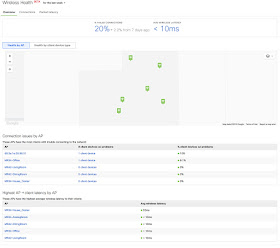Recently at Mobility Field Day 3, I ran across this sweet little access point by Aruba. They call it the AP-387. I call it tiny, portable and FAST. It's their new flagship 802.11ac/ad outdoor access point.
They've designed it for maximum distances between APs of 300 meters (that's ~980 feet) and that is just about perfect for most outdoor bridge links. Notice, I said most. We all know of at least one or two bridge links that are pushing a mile long or more. This AP-387 has a 60GHz and a 5GHz radio built into this tiny, outdoor rated package and it is capable of multi-gigabit link speeds. Oh, and it can handle 'rain events' that might make a 5GHz link less than useable.
It has the ability to self-acquire a link by using the electronic scanning capabilities of the 60GHz antenna. It uses existing mounting hardware from the AP-270 (AP-270-MNT-H1/H2). If the link becomes disrupted or block, the radio can scan plus or minus 40 degrees horizontal and plus or minus 10 degrees vertical to re-establish the link. It can even re-engage the link through an RF bounce off of a flat smooth surface (should one exist) between the two ends of the link.
The narrow beam-width of the 60GHz radio lends itself to being co-located within 4-5 meters of another AP-387 using the same 60GHz channel. The AP will power on with the 60GHz radios backed off by 3dB if the AP is getting 802.3af power, which is way better than it not working at all unless it gets 802.3at power. You can see the full product demonstration in this Mobility Field Day 3 video and witness the graceful failover of the link from the 60GHz to the 5GHz radio without dropping the link. Skip to the 15 minute mark to see the link demo.
All of this is bringing me to this point. Doing outdoor mesh/point-to-point site surveys just got that much easier. The AP-387 weighs a fraction of the 17 pound (7.7 kilo) Cisco 1522 I used for my last outdoor survey (circa 2010).
I'll leave you with this video I made to document the insanity of me getting that 87 pound (40 kilo) site survey kit into the back of a Volvo 240 wagon once I'd completed the survey. Times have sure changed in what feels like a short eight years!







